As A Dozen Nets Dance - Inle Lake
Setting off in a long-tail wooden boat, an entire new world revealed herself to us. Myanmar has an abundance of natural beauty. This I knew from endless magazines, books and websites. To experience such magnificence personally was a gift bestowed upon us. One I had never thought possible to attain. For Myanmar somehow always seemed beyond my reach. During the past few years, I have been constantly taken aback by people who have never heard of the place and show no interest in learning about it. Let alone care about what’s happening there. This saddens me. Myanmar is a country brimming with gentle, kind people. Interesting people. It is home to majestic mountain ranges, valleys, enormous rivers, pristine beaches and Inle Lake.
Debbie and I gripped the ridged sides of the boat as our captain navigated his way through the dozens of wooden boats on the river. Peak-hour traffic took on a whole new dimension. Boats were scrambling for position on the choppy waters. The spray borne from the dense wood of the boat smashing, at an angle, onto the surface of the unyielding water, showered us with a sense of coolness. Dozens of two-stroke engines revved at full throttle creating an ear-splitting noise, which sliced through the already electrically-charged atmosphere. Excitement mounted as we had no idea what to expect. The masses, being transported along the waters in boats packed with every conceivable item, created the ideal scene for the most challenging jigsaw puzzle. Life it seemed, was so simple. Yet incredibly challenging. The scenes playing out before us created wonderment as to how resilient and inventive humans are.
The further out we sped, the quieter it became. Boats headed in all directions, disappearing along the many narrow waterways. Each one lined with thick reeds. Leading to where the travellers were meant to be that day. It was simply another day in the lives of so many. Whereas for us, we were slowly being transported along the mystical freshwaters of Inle Lake. United with Mother Nature on a level never experienced before. As we left behind the manic noise and frenzied pace of fellow travellers, a gentleness began wrapping its arms around the boat. The captain reduced speed and we made our way in a more subdued manner. Mountains greeted us through their reflections in the water. Birds welcomed us through song. The green hues of life on the banks beckoned.
Inle Lake, known as the heart of Shan State, lies peacefully in the middle of the country at an altitude of nine hundred metres above sea level. A gem held securely in the embrace of mountains. Her area of twenty-two kilometres long and ten kilometres wide is home to thousands people who live along the lake. She is the source of food and of life itself. A place of abundance. Bird, plant and animal life coexist along the banks of the clear waters. Memories of my trip to Ngorongoro Crater flooded back. There too exists the most wonderful ecosystem where life supports life.
The twenty-minute journey to Indein from Inle Lake provided its own excitement as our captain guided the boat along the narrow Inn Thein Creek. Thick vegetation, dilapidated bridges and muddy waters ignored us as we entered their territory. Nevertheless we felt like royalty making a grand entrance to the annual ball. A celebration of the wonders that are borne from Inle’s waters.
Pagodas and hundreds of ancient gold stupas mesmerised us upon arrival at the market town of Indein. Many had been restored to their former glory. Others were crumbling. The day was hot. However, we were grateful to have made the effort to wander into the hills to witness yet another staggering man-made sight. The stupas of Shwe Indein Pagoda. Each stupa had captured the mysteries of the past and retained them protectively. It was both fascinating and haunting to stand amongst these magnificent structures, at times feeling like a child drifting in a world of fantasy. We tried to imagine the events that had taken place on that soil hundreds of years ago. The past was deeply buried. Not ours for the taking.
Walking through the thicket amongst the stupas was somewhat nerve-wracking. A heightened awareness of snakes walked beside us. The thrill of coming upon ancient artefacts and statues enticed us to tread further and further. We wandered amongst ancient gods, goddesses and secrets. We experienced an array of emotions with each sighting. Trepidation, serenity, elation and wonderment accompanied us on our walk through history.
Needless to say, in Asia, no matter where one finds oneself, there is always a market. Always a buyer and a seller. One amusing incident illustrated just how important trading is, in that part of the world. Treading very cautiously through thick shrub, we came upon a most resolute saleslady. There was no getting away from her empty-handed. We felt that, for her sheer grit and for working in such a harsh environment, we needed to support her. Judging from her smile, she thought so too.
We climbed up a hill under a covered stairway. Thankful for protection from the sun. On either side of the stairs, for as far as one could see, were the most interesting objects to buy. I was in a state of bliss. However, reminding myself of the long hot walk back to the boat and the carrying of my purchases, I restrained myself as much as possible. Despite my best intentions, it was tough making the selection between woven baskets, marionettes, bamboo water coolers and other relics from the past. Presently in my home in Siem Reap, whilst I prepare that first cup of coffee of the day, those treasures from Myanmar carry rich memories. I am then appreciative of my lack of will power.
Sailing further along the lake, clusters of traditional bamboo houses perched themselves serenely along the banks. The woven strips of bamboo used to create the walls of each house allowed slithers of light and air through. The ripples on the water reflected their presence in a playful blending of colours borrowed from the sky and surrounds. Each home displayed their unique charm as it balanced on the powerful stilts supporting from the waters below.
We drifted between rows of floating gardens producing both flowers and vegetables. Once again, Man’s resilience and ability to recognise and value the natural resources available, was evident everywhere. A variety of traditional handicrafts such as, silk weaving and the making of jewellery, were on display. It was fascinating to witness a silversmith hard at work. His tools crude and worn. His fingers expertly turning each piece for inspection before laying them out on a tray upon the floor. Together with handicrafts of all natures, the trinkets were housed in cordoned off sections of a large floating barge. I admired the local folk who, barefoot, negotiated the rickety gangways leading to these stalls on water. I battled with a lack of balance brought on by the moving waters. Nothing was ever still. People permanently lived, slept, ate and worked in sync with the flow below.
There were those vendors who preferred to sell from their boats. Pulling up alongside our boat, they began the haggling sessions we knew so well from our time spent in China. They would drift alongside us for long distances before diverting their attention to the next group of tourists, gliding across the waters in an attempt to meet their target for the day.
The afternoon heat was intense. We welcomed sailing on the water as a gentle breeze attempted to dissipate the sweat pouring off our faces. Clutching our umbrellas, we noted the pagodas set back from the banks of the lake. There is something so deeply sacred in seeing those places of worship. A sense of spirituality was ever-present.
Stopping at a market, bound for home, provided a deeper insight into life on the lake. A photographer’s paradise it was. A place where people from all ethnicities came together. To bargain. To exchange. Debbie and I had so much fun. We had opened a treasure chest of uniqueness. A tapestry of faces, items, sounds and smells lay before us. To be explored. From which to learn. We were the only foreigners on that intense playground of culture and felt completely at home.
The market provided a platform on which everything diverse existed. Amongst the many colourful head scarves being worn, was clothing of black. Extreme concentration and silence enabled buyers to carefully count eggs. Children ran free, giggling. Certain folk sat in solitude. Others formed groups. Their banter adding a certain vibrancy to the day.
There were those who cooked for hungry folk. On open fires. A lone soul displayed her one simple bunch of flowers for sale. Then brought out three cucumbers to add to her produce. I admired her resilience. How she displayed a sense of self-respect. She wasn’t stealing or waiting for handouts. She was trying to eke out a living as best as she could. Others weren’t so content. Their pain and suffering etched deeply onto their faces. I felt for them.
Gruesome masks and strings of teeth adorned wooden structures. I declined from asking as to their origin. Bamboo hats and brightly coloured woven bags were clumped together in colourful unity. In contrast to the heavy duty Chinese trucks which stood abandoned in a field. Sinister in their presence. Creating an aura tinged with intrigue and doom.
A man sat quietly to one side arranging the betel leaves. He created circular patterns with them as customers made small purchases. The leaves would later be rolled around a mixture of Areca nuts and slaked lime. This combination provided both stimulant and narcotic effects. And badly stained teeth resembling bleeding gums.
It would take far too long to describe each of the fascinating people we met along the way. As always, captured images best portray a story. People are what matter most. Anywhere in the world. I derive pleasure in simply observing people’s faces. Seeing their characters, how they react to others and how they react to the environment. Through my experiences of sharing diverse cultures and beliefs of others, it is the smile that crosses all borders. That precious act of kindness which acknowledges another.
The sun was dipping towards the horizon. A touch of disappointment filled the air as, despite having had the most amazing day, we had not seen the famous fishermen of Inle Lake. Our chances were slim at that stage. Before us lay the expansive lake and the journey home. The waters were devoid of human activity.
Our deeply relaxed state, into which we had both slipped, was interrupted by the sudden change of pitch in the droning of the engine. We slowed right down until the boat bobbed on the water. The engine was silenced. Our spirits flew into high mode when noticing the fishermen on the horizon. Beautifully silhouetted against a huge sky. Closer they came until they pulled up beside us. It was a moment of disbelief. Witnessing such incredible balancing acts, whilst controlling the huge billowing nets, was astounding. Bearing in mind that the process was performed on gently rocking boats on an uneven, continually moving surface. Time stood still for a few minutes. As a dozen nets danced.
Reeds and masses of thick floating plants cover large areas of Inle. This presents problems for the fishermen. They can’t see what’s ahead of them if they are sitting down. Hence, they adapted this unique technique of controlling the boat by wrapping one leg around the oar. They then balance on the other leg whilst manipulating the huge fishing net. Watching this style of fishing contributed to the ambience of the scene playing out before us. The dance of a dozen billowing nets. Elegant and powerful. Each one seemingly serenading an unseen force.
The colour of the water at times turned inky black as clouds gently moved in front of the sun. The dance of the nets played out, disappearing beyond the horizon once more. We headed back to Nuang Shwe.
To be continued …




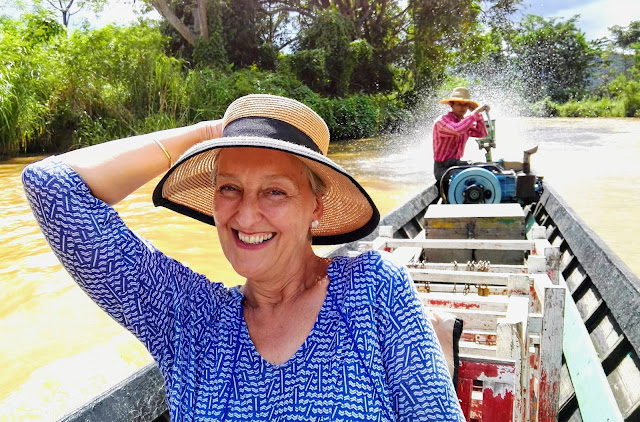







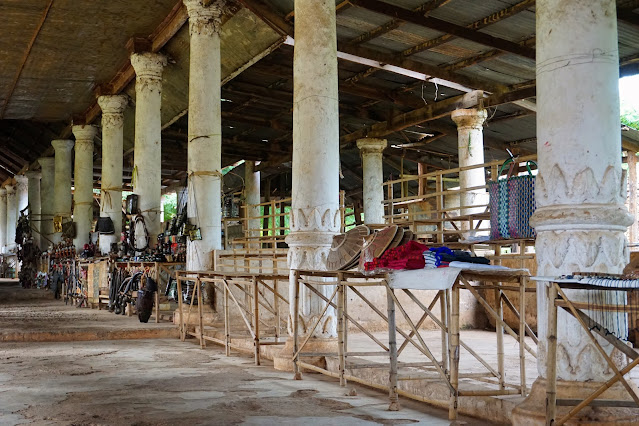





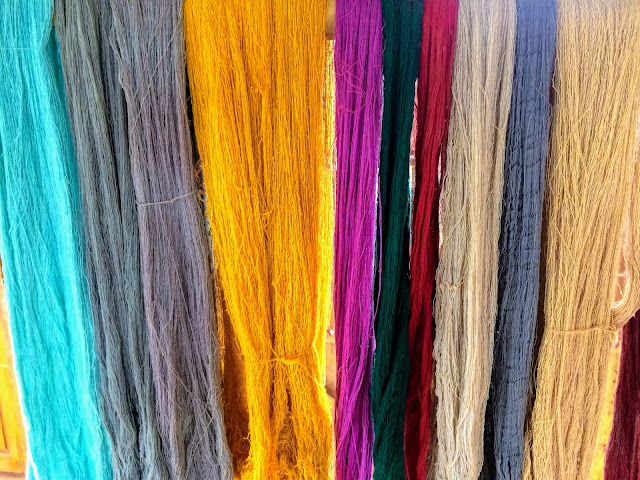



















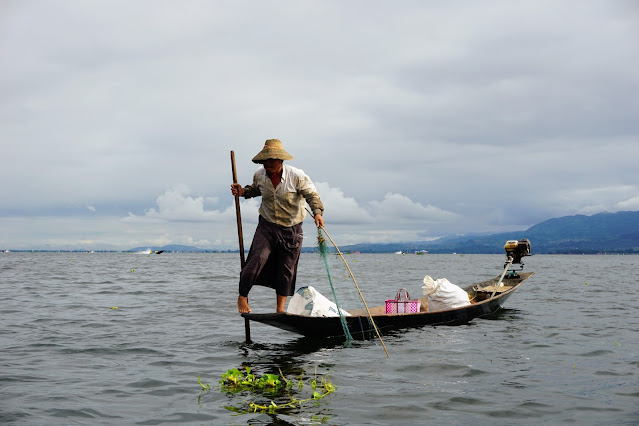
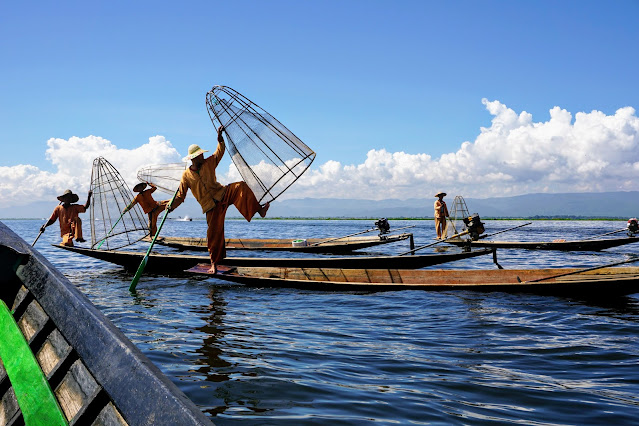
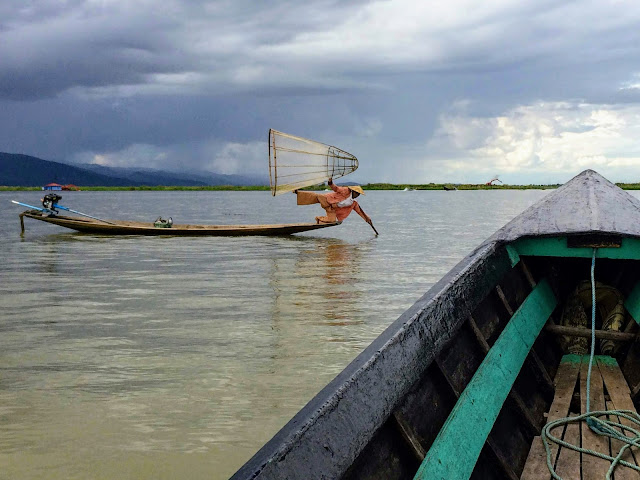



Wonderful Ingrid . Great description and pictures. A unique experience to have spent time in Inle Lake. Isn’t that where they grow the tomatoes in the lake on floating growing beds? I remember the weaving done from Kariba weed. What’s the other name for the weed? Great stuff Ingrid. Sell the article to Fair Lady mag please,
ReplyDelete